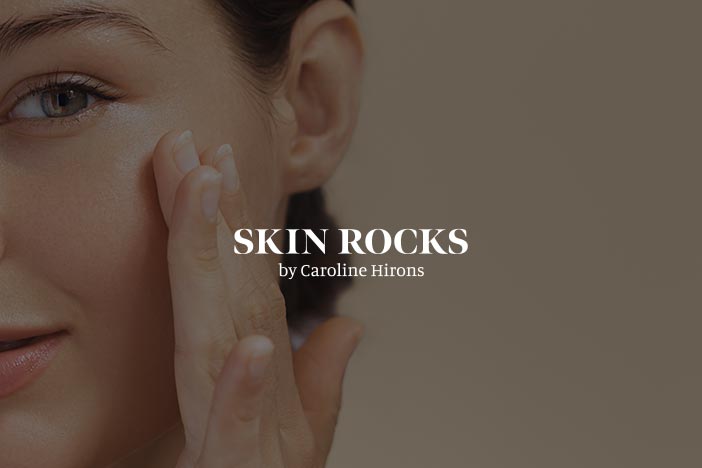Media Feature
Sep 24 | Media Feature in Skin Rocks by Caroline Hirons

Dr Elizabeth Hawkes
September 24, 2024

Expert Insights from Dr Elizabeth Hawkes
Oculoplastic Surgeon Dr. Elizabeth Hawkes Talks Eye Health, Surgery and Aesthetic Treatments
In honour of National Eye Health Week, we had the pleasure of talking to multi-award-winning Consultant Ophthalmic/Oculoplastic Surgeon and Aesthetic Doctor Dr. Elizabeth Hawkes.
As a leading eye expert in the UK—specialising in complex aesthetic eyelid surgery and blepharoplasty—Dr. Elizabeth Hawkes is Head of Oculoplastic Surgery at the internationally renowned Cadogan Clinic in Chelsea. Serving as the oculoplastic surgeon on the Aesthetics Journal's clinical advisory board, she is known for her meticulous surgical outcomes and advanced facial aesthetics. Here, we discuss hot topics in eye health, surgical and non-surgical treatments, and gain expert insights into this fascinating area of aesthetics.
Hi Elizabeth, thank you so much for sharing your time and expertise with Skin Rocks. As a leading oculoplastic surgeon and aesthetic doctor, what are your most requested clinical procedures?
In terms of non-surgical procedures, my most requested are Profhilo and Polynucleotides. Profhilo is a highly effective anti-ageing treatment, based on hyaluronic acid. It is injected into predetermined facial points, also known as the bio aesthetic points, to give a “hydrolift” effect. The treatment is an injectable that is performed over 2 sessions spaced approximately 4 weeks apart, with minimal downtime. Profhilo helps to boost skin hydration and tighten the skin, like an injectable moisturiser. The active ingredient is pure, non-crosslinked Hyaluronic acid—which can hold 1000 times its weight in water thus creating a significant moisturising effect. Profhilo studies have shown that injecting hyaluronic acid superficially into the dermis of the skin where Hyaluronic acid is made remodels the skin by stimulating elastin and collagen production. It can be used on the face, neck, chest, hands and even on the body. It is not something that is suitable for the eyelid area, however, because the skin is too delicate. Using Profhilo, we can help to achieve a firmer, plumper skin with a smoother texture.
I am seeing a major trend towards the use of Polynucleotides in my practice. These are very popular for non-surgical eyelid rejuvenation. They promote cellular repair, boost collagen production, increase microcirculation and improve skin elasticity. They work as a skin booster for the delicate eyelid skin providing subtle, natural-looking results without drastic changes. They have minimal downtime and side effects. The procedure really does define the term ‘lunchtime tweakment’.
We get many queries around hooded eyes and treatments. Is there anything topical you can apply/anything you can do to help hooded eyes—other than surgery?
Hooded eyes occur when we have excess skin between the brow and the lash line: This can be a genetic feature, but most commonly it is a function of age, because our eyelid skin loses its elasticity and thins which leads to redundant folds of skin over time. The muscles around the eye (orbicularis oculi) and the orbital septum also weaken, allowing fat to prolapse above and below your eyelids. Unfortunately, when hooded eyes develop, there isn’t really a good topical or non-surgical solution. At this point, the gold standard approach is a surgical blepharoplasty.
As with many things in medicine, prevention is key. Looking after the eyelid skin quality prior to the development of hooding is the best way to delay or reduce its severity. Retinols, applied topically, increase cell turnover and can help increase collagen production. Injected polynucleotides are another way to improve skin quality—these DNA-fragment based products have an anti-inflammatory effect by reducing oxidative stress occurring in the eyelid skin. They neutralise free radicals and help your body repair damaged cells. It encourages collagen production, helps protect skin against damage from the environment and can improve pigmentation caused by sun damage and scarring.
While lifestyle changes may not permanently eliminate under-eye bags, making healthy choices can help reduce their appearance. Here are some tips to help:
- Prioritise sleep: Getting adequate sleep is crucial for maintaining healthy skin. When well-rested, the skin around your eyes will appear more plump and firm.
- Watch your salt intake: Reducing the amount of salt in your diet can help reduce the appearance of under-eye bags.
- Use cold compresses or ice globes: Applying a cold compress or ice globes to the under-eye area can help reduce swelling and puffiness.
- Stay hydrated: Staying hydrated is essential for healthy skin. Be sure to drink plenty of water throughout the day.
- Address allergies and sinus problems: Allergies and sinus problems can cause under-eye bags. Treating these conditions can help reduce their appearance.
- Quit smoking: Smoking can damage the skin around your eyes and contribute to the appearance of under-eye bags. If you smoke, quitting is the best way to improve the health of your skin.
- Use sunscreen: Sunscreen protects your skin from harmful UV rays. These rays can damage the skin around your eyes and contribute to the appearance of under-eye bags. Apply sunscreen every day, even on cloudy days; there are a number of these on the market—the key is to find a product which has been specifically designed for use on the eyelids.
There is much talk around trough fillers vs Polynucleotides: What are the main differences, benefits and risk factors?
Trough filler is one of the most effective treatments to combat tired-looking or aged eyes; they are a hyaluronic acid-based injectable used to reduce dark circles, eye bags and a tired-looking appearance. With minimal to no downtime, they are an effective treatment to combat tired-looking or aged eyes. The natural ageing process and various lifestyle aspects can contribute to an aged appearance around the eyes, but careful administration of fillers under the eyes helps replace lost volume, conceal dark circles and smooth the skin. This results in a more youthful appearance overall. In general, dermal fillers are very safe. However, there are some rare side effects such as filler migration and even irreversible loss of sight.
Polynucleotides are a new type of injectable treatment which consist of naturally occurring polynucleotide chains, which have a highly moisturising effect. They restore the skin’s firmness, tone and elasticity. They are recommended for regenerating sagging and dehydrated skin rather than a super hydrator like Profhilo. This can be an excellent option for the under-eye area in people who are prone to puffiness and may not be suitable for hyaluronic-based treatments. The risks are minimal.
What would you say is your hero ingredient to look out for in eye creams/eye products?
Vitamin C (also known as ascorbic acid) is a powerful antioxidant and one of the few skincare ingredients that has been proven to help in the battle against skin ageing around the delicate eye area. It neutralises free radicals and helps your body repair damaged cells. It encourages collagen production, helps protect skin against damage from the environment and can improve pigmentation caused by sun damage and scarring.
What are your thoughts and advice on lash extensions?
People need to be very careful with lash extensions. Many people find they are allergic to the glue, which can lead to allergies, infections and even lash mites. If you do opt to have lash extensions, you must clean them properly, even if it means they don’t last as long. Continuously adding glue to your lash line can lead to irritation and lash loss so you should always make sure you are cleaning your eyelids properly. If you have eyelash extensions and want to remove them, make sure you have them taken off professionally as pulling them off yourself will damage your natural lashes. If you break or damage your eyelashes, your eyes become more susceptible to infections.
Do you see medical issues with your clients as a result of makeup use?
Yes, I see signs of sensitivity caused by residual mascara and eye make-up including redness, watery eyes, itching, as well as puffy eyes or even blurry vision. Sleeping in your make-up may also increase your chances of seeing milia, which are small white bumps that appear when keratin, a protein that your body produces naturally, gets trapped beneath the skin’s surface.
Eyelids are also a common location for contact dermatitis [aka eye eczema], so to help prevent dry eyelids it’s very important to keep them clean. When you’re tired, you are prone to rubbing your eyes, which can irritate them and also risks causing damage to the eye itself or surrounding areas.
What are the most important considerations when using makeup products on the eyes?
Our eyelashes aren’t just there for aesthetic purposes, they do a vital job protecting our eyes, helping to deflect anything that is coming towards the eye that could harm it. It’s not uncommon to have sensitive eyes when it comes to mascara and eye make-up since the skin near the eyes is so thin and delicate. I would say the following points are key:
- If you’ve had your mascara for more than three months, I’d suggest throwing it away as that can definitely cause sensitivity.
- When it comes to formulas, avoid mascaras with wax, parabens, fragrance as well as phthalates, which are used in cosmetics to control viscosity, emulsify and bind fragrances.
- Another tip for those with sensitive eyes using eye make-up is to avoid getting the brush too close to the lash line. I would suggest wiggling the brush in the middle of the lashes and then gently moving out to the tips.
- Avoid sharing mascara with others as this can spread infections as well as causing sensitivity.
What are your thoughts on TikTok lash trends such as the use of Castor Oil/Vaseline on the lashes and eye area?
While castor oil has been used in traditional medicines for many years, it is not meant to be used on or near the eyes. The general castor oil you may buy in the shops could contain added fragrances and be un-sterilised.
It is certainly not suitable to help treat dryness, floaters, cataracts, poor vision or even glaucoma, as some TikTok videos have claimed. There is minimal evidence about this and if you have concerns around your eyes, you should see an ophthalmologist. While castor oil is a common ingredient in many eye drops due to its lubricating properties, I do not recommend using pure castor oil in the eyes.
I have seen a large number of patients in my clinic who are having problems with lash serums. My general advice is that it is not a good idea to use these products for cosmetic purposes. There are lots of alternative formulas that do not contain prostaglandins. It’s safer to protect the lashes you already have, rather than trying to grow new or longer lashes. This can be done in a number of ways:
- Have a diet rich in proteins, leafy greens, and healthy fats to support hair growth and careful, gentle and thorough removal of makeup and pollution at the end of each day.
- All traces of make-up should be removed in order to prevent broken lashes, irritation, corneal abrasions and infections.
- Eyelid hygiene, as directed by an ophthalmologist, should be performed daily, to keep the eyelid gland entry points clean, and reduce the chance of developing blepharitis. Blepharitis is an inflammatory condition of the eyelids, which can result in eyelash loss.
In light of the prostaglandin controversy around lash growth serums, what would you say are the biggest risks to eye health from using these products? Have you seen the outcomes of this first-hand since lash serums boomed?
One of the most popular ingredients used in lash serums are compounds called prostaglandins and their analogues, which were originally developed for the treatment of glaucoma but repurposed when it was realised that they had the side effect of making lashes grow longer. While these compounds do increase lash length, they can also cause hyperpigmentation of the skin of the eyelid, darkening of the iris (ie: changing the eye colour) and atrophy of the fatty cushion around the eye (known as fat atrophy). These are all often undesirable to the patient and can be very challenging to treat.
Can lifestyle changes have a visible impact on under eye circles/bags?
While dark circles aren’t always a sign of tiredness, they can be due to other factors such as genetics or allergies. There are also specific causes that can have an impact on under-eye circles/bags:
- Genetics: pigmented skin due to ethnicity because of higher levels of melanin. Family history of dark circles.
- Vascular: The eyelids are very vascular, and due to poor circulation the vessels can become dilated. This will make them more apparent under the eyelid skin and cause an appearance of dark circles.
- Allergies: such as hay fever and eczema will also cause dilation of the blood vessels and can cause hypertrophy and erythema of the eyelid skin which contributes to the appearance.
You should stay hydrated by drinking enough water, avoid smoking, get enough sleep and take steps to protect your skin from UV such as wearing sunglasses and SPF. It is also a good idea to follow the guidance below:
- Apply an eye cream at night to keep the delicate skin around the area moisturised. The skin around your eyes is unique and very delicate, and therefore requires very special care. There are many eye creams out there that are specially formulated to lift and sculpt.
- Make sure to use serums and light creams that are formulated for daily use and don’t clog up glands.
- Be gentle when applying an eye product. It should be applied along the orbital bone—the eye socket—and not on the eyelids too close to the lash lines. Using your ring finger, work from the inner corners of the eyes outwards with a gentle patting motion.
What are the best non-invasive treatments for reducing signs of ageing around the eyes?
Polynucleotides are excellent for regenerating ageing, sagging and dehydrated skin.
What’s the biggest myth about eye care or eye-related skin care that you encounter?
The biggest myth that I’d like to ideally eliminate from discussion is that SPF should not be used on the eyelids. This is often suggested because people feel that the eyes can be irritated by the products. However, the eyelid is a high-risk area for skin cancer—it is therefore imperative that SPF is used on the upper and lower eyelids, together with UV-400 sunglasses to protect the skin.
NLA licensed copy. No further copies may be made except under licence. This article originally appeared in Skin Rocks by Caroline Hirons on September 24, 2024.
Get in Touch
Considering a procedure or have questions? Dr. Hawkes is here to help. Please reach out for consultations or inquiries.
